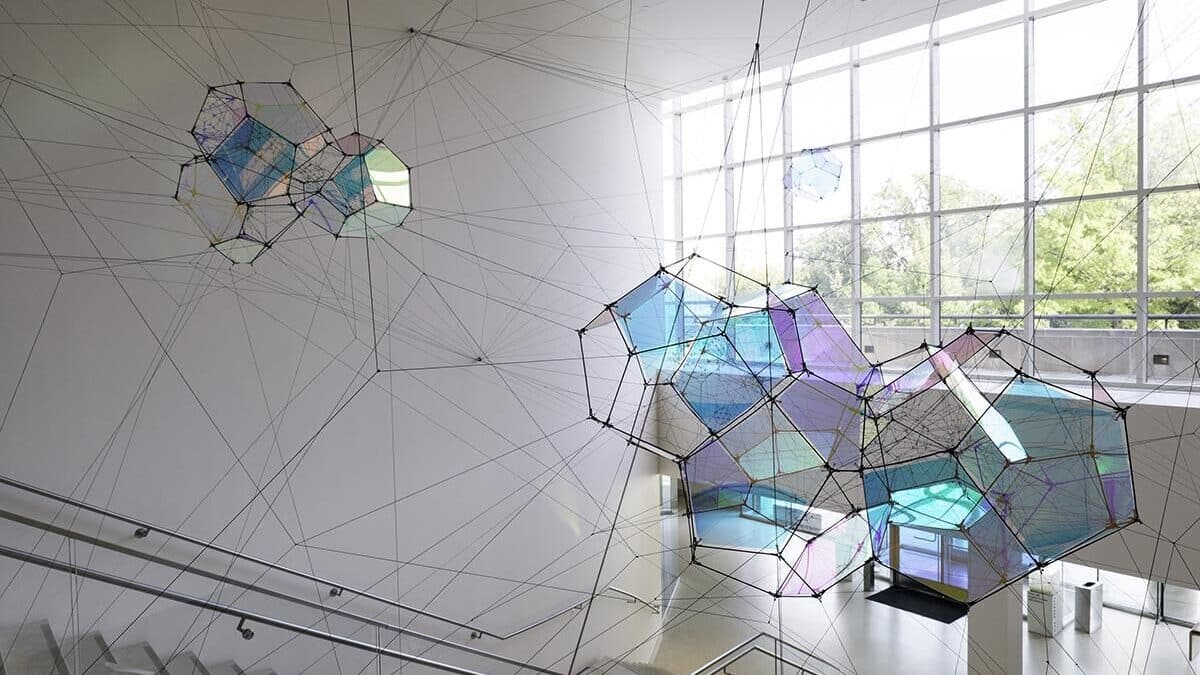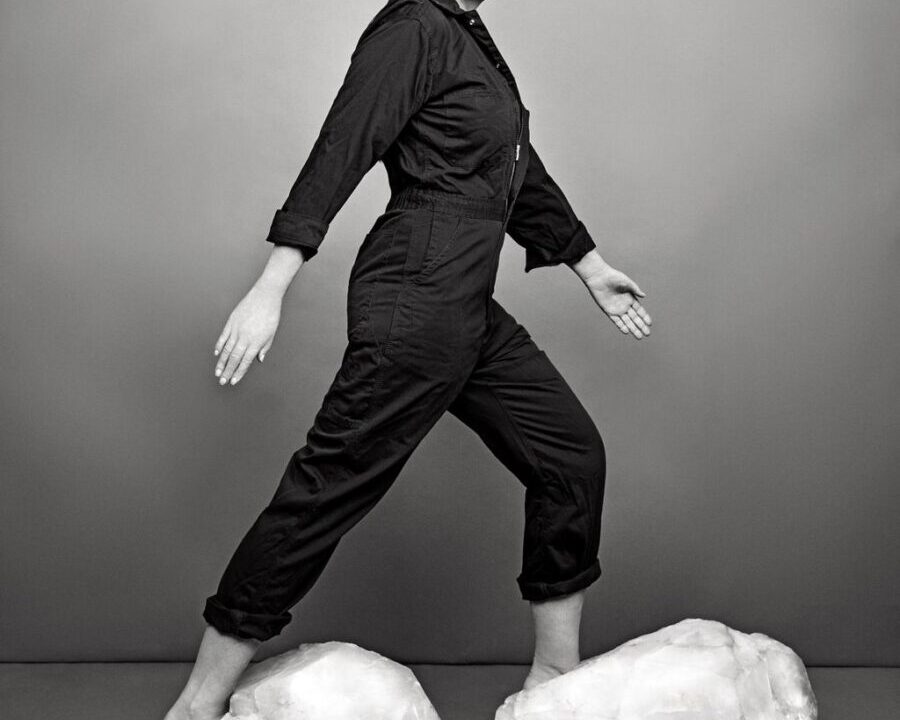An artist trained as an architect, Tomás Saraceno employs insights from engineering, physics, chemistry, aeronautics, and materials science in his work. His interactive and evolving artistic structures are speculative models for alternate ways of living for a sustainable future. Best known for his large-scale installations and floating sculptures, Saraceno’s interdisciplinary approach to art explores new, sustainable ways of sensing and inhabiting the environment, the result of research into the origins of the observable universe, arachnology and the potential future for airborne dwelling. His work sits at the crossroads of art, science and architecture.
“For years now, the Argentine artist-futurist Tomás Saraceno has been imagining humanity’s ascent from terra firma to cities that would hover above nationalism, political division, fossil-fuel dependence and parallel parking.” — New York Times, December 14, 2016
The Life and Art of Tomás Saraceno
Tomás Saraceno was born in San Miguel de Tucumán, Argentina in 1973. He studied architecture at Universidad Nacional de Buenos Aires in Argentina from 1992 to 1999; he then studied art and architecture at a postgraduate program at Escuela Superior de Bellas Artes de la Nación Ernesto de la Cárcova, also in Buenos Aires. Afterward, Saraceno moved to Europe to complete his postgraduate studies at Städelschule. There, he was directed by Daniel Birnbaum, curator of the 53rd Venice Biennale, and studied under professors Thomas Bayrle and Ben van Berkel. In 2003-2004 Saraceno participated in the course “Progettazione e Produzione delle Arti Visive” (Design and Production of Visual Arts), held by Hans Ulrich Obrist and Olafur Eliasson at Instituto Universitario di Architettura di Venezia.
Saraceno’s first installations were exhibited at the Venice Biennale of Architecture in 2002 and again at the Venice Arte Biennale in 2003, as well as at the São Paulo Biennale of 2006.
Saraceno established his studio in Frankfurt am Main in 2005. The studio relocated to Berlin in 2012 and then moved into the former administrative building of Actien-Gesellschaft für Anilin-Fabrication in Berlin-Rummelsburg, constructed in 1916.
In 2009, Saraceno attended the International Space Studies Program at the National Aeronautics and Space Administration’s Ames Research Center in Silicon Valley, California. That same year, he exhibited again in Venice, this time at the 53rd Arte Venice Biennale “Fare Mondi/Making Worlds”, curated by Daniel Birnbaum, and won the Calder Prize.
In 2012, he became the first residing artist at the Center for Art, Science and Technology (CAST) at the Massachusetts Institute of Technology, resulting in an ongoing collaboration. He held residencies at Atelier Calder (2010) and Centre National d’Études Spatiales (2014–2015), among others.
In 2015, Saraceno launched the Aerocene Foundation, an open-source community project for artistic and scientific exploration of environmental issues.
During the past decade, Saraceno has initiated collaborations with renowned scientific institutions, including the Massachusetts Institute of Technology, Max Planck Institute, the Nanyang Technological University of Singapore, and institutions of the Exhibition Road Cultural Group, among them Imperial College and the Natural History Museum London. These collaborations and residencies have crucially influenced Saraceno’s ongoing artistic research and development.
Famous Works and Exhibitions
Tomás Saraceno’s works entangle diverse threads of thought, including art, life science, and the social sciences. Enmeshed at the junction of these worlds, his floating sculptures, community projects, and interactive installations propose and explore new, sustainable ways of inhabiting and sensing the environment. Some of his most famous works are inflatable and airborne biospheres with the morphology of soap bubbles, spider webs, neural networks and cloud formations.
- Cloud Cities, Hamburger Bahnhof, Berlin (2011–2012)
Cloud Cities consisted of a collection of geometric, inflated shapes that challenged the notions of place, space, future and gravity. The exhibition sought to explain how human beings live in connection with their environment. The shape and size of the exhibited city could be changed continually, subjecting to critical scrutiny conventional ideas about boundaries and territories. The works Saraceno created as part of this exploration were components of a future cloud-city, but also existed in isolation as independent sculptures or installations, evincing forces and qualities of their own.
- On the Roof: Cloud City, The Metropolitan Museum of Art, New York (2012)
In 2012, Saraceno exhibited On the Roof: Cloud City in the Iris and B Gerald Cantor Roof Garden at the Metropolitan Museum of Art. A constellation of sixteen large, interconnected modules, its glass segments were cut in non-identical geometric shapes held in place by steel joints, reinforcements, and steel cables. Visitors were able to walk through the installation, which drew its shapes and formations from bacteria, clouds, foam, and neural communication networks.
- Aerocene, at Solutions COP21, Grand Palais, Paris (2015)
Aerocene explored environmental issues scientifically and artistically. It consisted of sculptures kept in the air by the sun’s heat and infrared radiation, and the exhibit was officially presented during the United Nations Climate Change Conference COP21, at Grand Palais, Paris, 2015. Afterward, a similar prototype, the D-O AEC Aerocene, was tested at the White Sands Dunes of New Mexico; on November 8, 2015, the prototype broke world records by achieving the longest and most sustainable certified flight without fossil-fuels, solar panels, helium, or batteries. With a net lift of more than 250 kg, the payload of the D-O AEC Aerocene solar sculpture has no precedent in the long history of manned solar balloon flight attempts.
- Solar Bell Ensemble, Contemporary Arts Center, Cincinnati (2016)
Saraceno’s Solar Bell is a flying sculpture made of lightweight and sustainable materials. Its design is based on the modular tetrahedron, or four-sided pyramid, invented by Alexander Graham Bell during his early investigations into manned flight. Solar Bell was the final project in a series of artworks created to accompany the expansion of the Port of Rotterdam with the construction of Maasvlakte 2 in the Netherlands in 2013.
- Hybrid Webs, “May You Live in Interesting Times”, Venice Biennale (2019)
Uniquely, Saraceno has conducted extensive arachnology research, having scanned, reconstructed and re-imagined spiders’ woven spatial habitats, and he possesses the only three-dimensional spider web collection in existence. The secondary output of the research conducted in his Arachnid Research Lab are the Hybrid Webs, a series of sculptures made entirely of spider silk designed to appear as a unique, geometric galaxy floating in infinite space. During the building period, the sculptures are turned onto each side, allowing gravity to aid the interweaving of silk from different sorts of spiders. The final series is a symbol of an encounter which might not otherwise have succeeded, and so prompts a reflection on human coexistence with the natural world. Hybrid Webs has been exhibited worldwide.
Value at Auction
Tomás Saraceno’s Airport City/Cloud-City, 6 Cloud Modules/60 Solar was estimated by Sotheby’s Auction House at 30,000-50,000 GBP and sold for 47,500 GBP in April 2020.
Saraceno’s Model (TS_M01) was estimated by Sotheby’s Auction House at 15,000-20,000 GBP and sold for 16,250 GBP in November 2019.
Add the Works of Tomás Saraceno to Your Own Collection
Keep an eye out for live auctions in Dania Beach for the chance to add a work from this artist to your collection. There are opportunities to participate in auctions via phone or online from anywhere in the world.
Selling the Works of Tomás Saraceno
Do you have works by Tomás Saraceno that you are interested in selling, appraising or cosigning? Call Joshua Kodner today, and ensure you receive the true value of your property.




